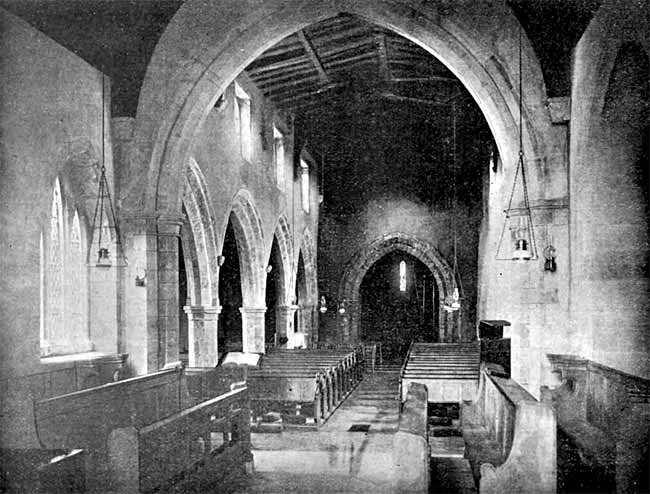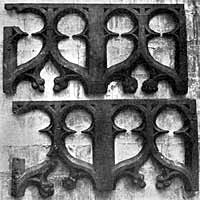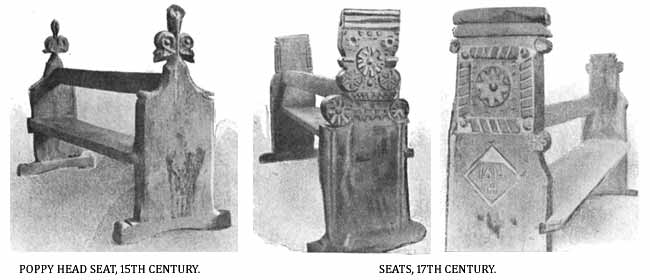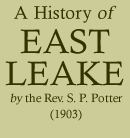< Previous | Contents | Next >
NOTES ON DETAIL.
There are no monuments in the church. Torre speaks of two testamentary burials—that of “William Umfrey of Ester Lekes” who willed (December 3rd, 1346) that his body should be buried in the Church; and “John Bussey of Boroby in the parish of Leke,” who desired (will, April 3rd, 1484) “to be buried in the High Qere ( = Quire)?" The latter is an error for Leake in Yorkshire, in which parish there is still a hamlet of Borrowby. The will speaks of Leke, in the county of Yorks., and Torre must have overlooked this.

INTERIOR OF CHURCH, LOOKING WEST.
A slab of alabaster was found at the restoration beneath the chancel floor, and may have been the covering of a. grave.
 FRAGMENTS OF SCREEN.
FRAGMENTS OF SCREEN.Sixty years ago there was a screen dividing the chancel from the nave. Unfortunately, it was not then considered worthy of restoration. From fragments which remain it would appear to have been 15th century work of simple but effective design. It is satisfactory to have sufficient of the original work to reproduce the design when the opportunity occurs.
It is plain, from an examination of the Easternmost arch of the arcade, that there was once a rood loft. A parclose screen appears to have enclosed the altar in the aisle. There are traces observable both on the capital of the East pillar, and the South wall of the aisle, where this was fixed. The hole in the South wall has been thought, with less likelihood, to mark the position where was placed a figure of the Saint to whom this side altar was dedicated.

The few remains of the original seats are interesting. Those with the poppy heads are of the 15th century, while the more massive and rugged ones are early 17th century work. One of these bench ends is dated 1612. In 1844 the church was reseated in the box pew manner, then general, and the massive oak benches, probably grown and worked in the parish, were banished. It is useless, however natural, to lament these losses.
The lectern was made out of oak taken from the bell chamber, and was presented to the Church on Christmas Day, 1902, by Mr. George Goodband, a Sidesman of the Church.
The 13th century octagonal font is situated in the ancient position, beneath the Westernmost arch of the arcade of the same date. Above it is the pulley by which the cover was raised. On the North and South sides of the rim of the font are clearly traceable the remains of staples used, according to the order of Archbishop Edmund, in 1236, for locking the font covers against superstitious misuse by intruders. The south edges of the basin are much worn, through the sharpening of some instruments—the more prosaic say pocket or girdle knives; the less prosaic, arrow heads. It is quite possible that this portion of the Church was once used as a school, and, if this was the case, the damage might be accounted for without much difficulty.
A detail in the bell chamber is of peculiar interest. There is a round headed doorway above the tower arch, which is now blocked up on the Church side, but is visible from the chamber. A careful examination has revealed the holes on the North side, where the hinges were fixed. It is a matter of debate for what purpose this door was used, but it is quite probable that when the tower was built this chamber was intended for a priest’s or sacristan’s chamber, with access from within the Church. Galleries were early fixed at the West end of churches, and it is possible that access to the chamber was obtained by way of the gallery.
Upon the beams of the nave roof and aisle are indications of the continual repairs done to the Church, and the time when they were done.
There is an interesting record of repairs upon the roof of the aisle. On the Easternmost beam to the left is painted in dark lettering
| “Richard Yarwoode | } | Churchwardens.” |
| William Marcer | } |
and to the right,
“by me Robert Wight June 23 1638"
On the beam next to it, under the same date, we have the rhymed inscription painted in the same manner:—
“ Richard Hutchinson and his sons did frame this work that here is mayde
And at it the(y) all wrought full sore that when the(y) had done the(y) might be payde”
The oak pegs West of the South door beneath the wall plate were probably fixed there to suspend the Church ladder.
The four brass candelabra, of late 18th or early 19th century work, were purchased—if tradition speaks truly— from the local Baptists. Two of these were restored, and brought into use again in 1898.

CARVED OAK PELICAN.
The carved oak pelican, mentioned by Throsby, is fortunately preserved. It was formerly fixed in the bench end of the Manor House seat, on the North side of the Church. A second carved figure, which was in the possession of the landlord of the Three Horse Shoes Inn, was destroyed by a thoughtless charwoman, as recently as 1901.
Two large, weird canvas pictures, representing “Death” and “Time,” once hung over the old gallery, on either side. They survived the gallery some twenty-five years. At the restoration, in 1886, they were removed, and, falling into decay, perished. Canvasses containing The Creed, The Lord’s Prayer, and The Ten Commandments, which occupied positions to the right and left of the Royal Arms, over the entrance to the chancel, perished at the same time.
The iron clock, now standing at the West end of the nave, figures in the churchwardens' accounts from their commencement in 1791, an item in that year being “1/- paid to the Clerk for oiling the clock.” It continued in use until late in the last century.

TIN TRUMPET, LOCALLY CALLED “THE SHAWM.”
No relic is so famous as the tin trumpet—locally called The Shawm. Similar trumpets are found at Braybrook, and Harrington, in Northamptonshire; at Willoughton, in Lincolnshire; and at Charing, in Kent. One formerly existed at Thorney, in Lincolnshire. The East Leake trumpet is the most perfect specimen of these. Its dimensions are 7 feet 9 inches when extended, and 4 feet 1 inch when, trombone-like, it is closed. The mouth of the trumpet has a diameter of 215/8 inches. The original use of these trumpets is uncertain; but it is known that the Braybrook, Willoughton and Thorney instruments were, at one time, used for the purpose of summoning the congregation to Church.
There is no tradition of this use at East Leake. It was certainly used within the Church, and formed part of the gallery orchestra, a bass singer vamping the bass through it. It was used until about 1855. The Christmas singers also made use of it in their perambulations of the parish. Its preservation is largely owing to Mr. Charles Angrave, a member of an old East Leake family; and its replacement in the Church, to the Rev. C. S. Millard, Rector of Costock.
The parish plough was kept in the Church until the fifties of the last century.
EXTERNAL DETAILS.
There are a few external details of considerable interest. The carving upon the East window of the aisle is remarkable. It is not easy to trace the symbols, but the figures of the Blessed Virgin and Child are still traceable.
On the two buttresses East of the porch, about five feet from the ground, are dial-like circles, with radii. These may have been sundials.
On the East jamb of the window, Eastward of the porch, is a smaller circle, less distinct than the above. This is probably a dedication mark.
The sundial, now West of the porch, was formerly fixed upon the brick front of the old porch; and was removed and repainted in 1896. It bears the motto, “Now is yesterday’s to-morrow.” It is mentioned in Mrs. Gatty’s Book of Sundials.
THE BELLS OF ST. MARY’S CHURCH.
St. Mary’s Church has had a ring of three bells for 350 years at the very least. There is every reason for believing that for a much longer period three bells—emblem of the Holy Trinity—have hung in the tower. In addition to these a small bell for use at the Holy Communion, known as a sacring bell, hung either in the tower, or over the chancel arch, most probably in the former position.
The known history of the bells commences with September 4th, 1552, on which day an official inventory of the Church goods of East Leake was taken. In this is the entry “iii belles And that Richard Wild Thomas Asten and Thomas North are bound by recog: in xx (? £20) to answer for a sacring bel sold for 5s.” On the 8th of May, in the following year (1553), the Commissioners handed over the three bells to the Curate, Robert Watson.
Nothing is said of the sacring bell. It had neither been recovered, nor replaced, as yet.
The three bells, which had done duty in pre-Reformation times, failed one after the other. The first to give way appears to have been the third bell. It was conveyed to the foundry of Henry Oldfield, either late in the 16th or early in the 17th century. The earlier date is the probable one, for the inscription and lettering are the same as on one of the bells of Clifton, which bears date 1598. The inscription upon it is “IHESVS BE OVRE SPEDE.” It bears the trade mark of Henry Oldfield. The first bell presumably failed next, and was recast by the same founder, whose trade mark is upon it, together with the inscription “GOD SAVE THE CHVRCH.”
The second bell was recast in 1627, with the same legend as the first bell, without the prefixed It had no founder’s mark, but the lettering was similar to that upon the first, so it may be concluded that it too was recast in the same foundry. Henry Oldfield died in 1620, so we may ascribe this bell to his successor, George Oldfield. If this inscription was suitable when the first bell was cast, much more so when the second, for the dark days of the reign of Charles I. were fast approaching. Churchmen had reason to pray “God save the Church.”
There is no record to tell us whether or no Messrs. Wild, Asten and North replaced the sacring bell; but the existence of the small bell, called the Ting-Tang, suggests that this was done. There is no founder’s or other mark, or inscription upon the bell, which, in the opinion of Mr. E. D. Taylor, of Loughborough, is old.
A village tradition says that this bell once belonged to the Bley Free School, but we have evidence that this fourth bell hung in the tower more than a century ago. Throsby visited the Church about 1793, and records that the Church tower contained four bells. Another traveller, Laird, relates that at the time of his visit—in 1813—there were “four well-toned bells.”
The terrier of 1809 enumerates three bells as belonging to the Church. This may be taken to imply that the fourth bell was not Church property, but it is possibly only an omission.
In the memory of many living the Ting-Tang was rung on Shrove Tuesday at noon, and this was known as the Pancake Bell. It is easy to connect this day’s bell-ringing with the shriving of old, which gave the day its name. This is one of many instances of customs being continued in spite of alterations in times and manners.
In 1902 the three heavy bells were found to be in bad condition, through want of quartering. They were removed to the foundry of Messrs. John Taylor & Co., at Loughborough, to be repaired and retuned. The second bell—being cracked —was recast, with the new legend “GOD SAVE THE CHURCH AND KING. 1902,” thus commemorating the Coronation of King Edward VII. The bells were rehung on a steel cage, as the oak cage was unsound. New floors were fixed in the belfry at the same time, and the Ting-Tang was rehung in the East window of the tower. The total cost of the repairs was £133, which sum was raised by subscription, and by monthly offerings in Church.
The present weight of the bells is
| Cwt. | Qrs. | Lbs. | |
| 1. | 4 | 2 | 15 |
| 2. | 7 | 1 | 12 |
| 3. | 8 | 0 | 11 |
